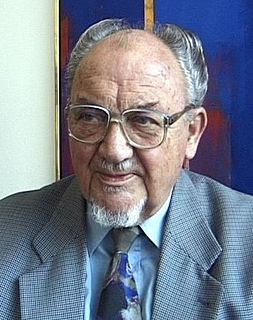The politics of the Faroe Islands a "constituent country" of the Kingdom of Denmark, function within the framework of a parliamentary representative democratic dependency, whereby the Prime Minister of the Faroe Islands is the head of government, and of a multi-party system. The Faroe Islands are politically associated with the Kingdom of Denmark, but have been self-governing since 1948. Executive power is exercised by the government. Legislative power is vested in both the government and the Løgting. The judiciary is independent of the executive and the legislature and the responsibility of Denmark. As of October 25, 2007, the Faroe Islands became one electoral district.

The Inatsisartut, also known as the Parliament of Greenland in English, is the unicameral parliament of Greenland, a autonomous country in the Danish realm. Established in 1979, it meets in Inatsisartut, on the islet of Nuuk Center in central Nuuk.
Sjálvstýri is a liberal and autonomist political party in the Faroe Islands. It is currently led by the Mayor of Klaksvík Jógvan Skorheim.

The Union Party is a conservative-liberal and agrarian political party in the Faroe Islands. The party wants to maintain the Faroe Islands union with Denmark. On 24 October 2015 Bárður á Steig Nielsen succeeded Kaj Leo Johannesen as party leader.
There are three types of elections in Denmark: elections to the national parliament, local elections and elections to the European Parliament. Referendums may also be called to consult the Danish citizenry directly on an issue of national concern.

General elections were held in Denmark on 4 December 1973 and in the Faroe Islands on 13 December. It has since been referred to as the Landslide Election, as five new or previously unrepresented parties won seats, and more than half the members of the parliament were replaced. The Social Democratic Party, which had led a minority government until this election, lost a third of their seats. After the election Poul Hartling, the leader of the liberal Venstre, formed the smallest minority government in Denmark's history with only 22 seats, supported by the Progress Party, the Conservative People's Party, the Social Liberal Party, the Centre Democrats and the Christian People's Party.

The Social Democratic Party is a social-democratic political party in the Faroe Islands, led by Aksel V. Johannesen.
The Centre Party is a Christian-democratic and conservative political party on the Faroe Islands, led by Jenis av Rana. The party is known for its traditionalist stance on social issues, in particular on LGBT rights and homosexuality in general.

Folketing elections were held in Denmark on 24 April 1929, except in the Faroe Islands where they were held on 29 May. The Social Democratic Party remained the largest in the Folketing, with 61 of the 149 seats. Voter turnout was 79.7% in Denmark proper and 58.0% in the Faroes.

Folketing elections were held in Denmark on 16 November 1932, except in the Faroe Islands where they were held on 12 December. The Social Democratic Party remained the largest in the Folketing, with 62 of the 149 seats. Voter turnout was 81.5% in Denmark proper and 59.2% in the Faroes.

Folketing elections were held alongside Landsting elections in Denmark on 30 October 1945, except in the Faroe Islands where they were held on 20 November. The Social Democratic Party remained the largest in the Folketing, with 48 of the 149 seats. Voter turnout was 86.3% in Denmark proper and 57.3% in the Faroes.

Folketing elections were held in Denmark on 22 October 1935, except in the Faroe Islands where they were held on 11 November. The Social Democratic Party led by Prime minister Thorvald Stauning remained the largest in the Folketing, with 68 of the 149 seats. Voter turnout was 80.7% in Denmark proper and 55.4% in the Faroes. It was in this election that the Social Democrats used the famous slogan "Stauning or Chaos".

Folketing elections were held in Denmark on 3 April 1939, except in the Faroe Islands where they were held on 19 April. They followed a dissolution of both chambers in order to call a referendum on changing the constitution. The referendum was held on 23 May but failed due to a low voter turnout. The result of the elections was a victory for the Social Democratic Party, which won 64 of the 149 seats. Voter turnout was 79.2% in Denmark proper and 47.8% in the Faroes.

Folketing elections were held in Denmark on 28 October 1947, except in the Faroe Islands where they were held on 18 February 1948. The Social Democratic Party remained the largest in the Folketing, with 57 of the 150 seats. Voter turnout was 85.8% in Denmark proper and 60.1% in the Faroes.

Folketing elections were held in Denmark on 5 September 1950, except in the Faroe Islands where they were held on 14 October. The Social Democratic Party remained the largest in the Folketing, with 59 of the 151 seats. Voter turnout was 81.9% in Denmark proper but just 22% in the Faroes.

Folketing elections were held alongside Landsting elections in Denmark on 21 April 1953, except in the Faroe Islands where they were held on 7 May. The Social Democratic Party remained the largest in the Folketing, with 61 of the 151 seats. Voter turnout was 80.8% in Denmark proper but just 20% in the Faroes.
General elections were held in the Faroe Islands on 8 November 1962. The Social Democratic Party emerged as the largest party in the Løgting, winning 8 of the 29 seats.
General elections were held in the Faroe Islands on 8 November 1966. The Social Democratic Party emerged as the largest party in the Løgting, winning 7 of the 26 seats.









